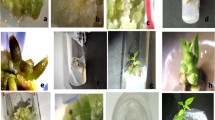Summary
Defined in vitro conditions for callus initiation byGossypium arboreum L. were determined, and different tissues were evaluated as explant sources. Environmental conditions tested included light versus dark, and low light versus high light. Different nutrient media as well as carbohydrate sources were examined. Our data show that hypocotyl tissue was superior to cotyledon or leaf tissue as the explant source for callus proliferation; the Murashige-Skoog inorganic formulation with (in mg per 1) 100 myo-inositol, 0.4 thiamine·HCl, 2 indoleacetic acid (IAA), 1 kinetin, and 3% glucose solidified by agar was the best medium to initiate callus. Cultures with sucrose as a carbohydrate source browned rapidly. Callus proliferation was superior under high light (8000 to 9000 lux) conditions at 29±1°C. Various combinations of auxins and cytokinins were tested for their ability to improve callus proliferation and subsequent growth of subcultures. Although the MS medium containing IAA and kinetin was found superior for obtaining rapid proliferation of callus from hypocotyl explants, a second medium containing 2 mg per 1 naphthalenacetic acid (NAA) and 0.5 to 1 mg per 1 benzyladenine (BA) was found necessary for vigorous growth of subcultured callus. A MS medium with 5 to 10 mg per 1 {ie329-1} (2iP) and 1 mg per 1 NAA was also favorable for continued subculturing.
Similar content being viewed by others
References
Carlson, P. S., H. H. Smith, and R. D. Dearing. 1972. Parasexual interspecific plant hybridization. Proc. natl. Acad. Sci. U.S.A. 69: 2292–2294.
Bajaj, Y. P. S. 1974. Potentials of protoplast culture work in agriculture. Euphytica 23: 633–649.
Bottino, P. J. 1975. The potential of genetic manipulation in plant cell cultures for plant breeding. Radiat. Bot. 15: 1–16.
Chaleff, R. S., and P. S. Carlson. 1974. Somatic cell genetics of higher plants. Annu. Rev. Genet. 8: 267–278.
Smith, H. H. 1974. Model systems for somatic cell plant genetics. BioScience. 24: 269–276.
Schenk, R. U., and A. C. Hildebrandt. 1972. Medium and techniques for induction and growth of monocotyledonous and dicotyledonous plant cell cultures. Can. J. Bot. 50: 199–204.
Beasley, C. A., and I. P. Ting. 1973. The effects of plant growth substances on in vitro fiber development from fertilized cotton ovules. Am. J. Bot. 60: 130–139.
Davis, D. G., K. E. Dusbabek, and R. A. Hoeauf. 1974. In vitro culture of callus tissues and cell suspensions from okra, (Hibiscus esculentus L.) and cotton (Gossypium hirsutum L.) In Vitro 9(6): 395–398.
Linsmaier, E. M., and F. Skoog. 1965. Organic growth factor requirements of tobacco tissue cultures. Physiol. Plant. 18: 100–127.
Sandstedt, R. 1973. Habituated callus cultures from two cotton species. Beltwide Cotton Prod. Res. Conf. Proc. 26: 52–53.
Hsu, C. L., and J. McD. Stewart. 1976. Callus induction by (2-chloroethyl) phosphonic acid on cultured cotton ovules. Physiol. Plant 36: 150–153.
Murashige, T., and F. Skoog. 1962. A revised medium for rapid growth and bioassays with tobacco tissue cultures. Physiol. Plant. 15: 473–497.
Walbot, V., and L. S. Dure, III. 1976. Developmental biochemistry of cottonseed embryogenesis and germination. VII. Characterization of the cotton genome. J. Mol. Biol. 101: 503–536.
Author information
Authors and Affiliations
Additional information
Technical Article 12485 from the Texas Agricultural Experiment Station.
Rights and permissions
About this article
Cite this article
Smith, R.H., James Price, H. & Thaxton, J.B. Defined conditions for the initiation on growth of cotton callus in vitro I.Gossypium arboreum . In Vitro 13, 329–334 (1977). https://doi.org/10.1007/BF02616179
Issue Date:
DOI: https://doi.org/10.1007/BF02616179




